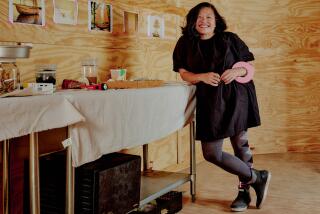Making Surplus Food Palatable
- Share via
So what do you do with a can of USDA pork and some dried eggs?
Deborah Mann High, a 31-year-old student at Hood College in Frederick, Md., noticed that many clients turned down such items at the Frederick Community Center food bank because they did not know how to prepare them, much less make them appetizing.
“It’s not easy,” High, who works at the center as part of her degree studies, said of the canned pork, plentiful through the U.S. Department of Agriculture’s surplus commodity program. “They’ve got to get the fat off it and the juice off it and work with it a little.”
When Mike Spurrier, an assistant director at the center, asked High to make a videotape demonstrating basic food preparation techniques, High decided to take the idea a little further.
Why not show people how to use the sort of items frequently found at food banks? And why not create easy-to-read, even pictorial recipes for clients who have problems reading?
The result was “Hey, You Really Can Eat This Stuff” -- a multimedia project that officially began recently when High, her 11-year-old son and other volunteers were videotaped preparing several recipes based on food bank items. The video will be shown to clients waiting in the food bank line.
The project also has five recipes written for those with limited reading skills and even two pictorial recipes for those who cannot read.
The recipe cards are to be laminated by the Women of the Evangelical Church, a Chicago-based volunteer group, then distributed free through the food bank.
Ultimately, High hopes to compile a cookbook. Her recipes include Chinese pork and fried rice, Southern-style pork and beans, muffins, honey corn bread and rice pudding. Besides canned pork, the recipes draw on such food bank staples as beans, dried eggs and rice.
“Hey, You Really Can Eat This Stuff” is, as far as High has been able to determine, the only attempt nationwide to provide inexpensive, nutritional food in easy-to-understand recipes. In searching for a prototype for her project, High called the Department of Agriculture, extension services, colleges and libraries and found nothing similar.
The program represents a large-scale cooperative effort, drawing on Hood students, Hood faculty, the Frederick Community Center, the Literacy Council of Frederick County, volunteers from Chicago and Kappa Omicron Phi, a home economics honor society. High is still looking for a company to donate three-ring binders to hold the recipe cards.
A home economics major at Hood, High used her experience as a nursery school teacher in devising her recipes. While children’s cookbooks usually are for single servings and seldom are made with Department of Agriculture commodities, High thought the easy-to-read approach of those cookbooks would be appropriate to her project.
More to Read
Eat your way across L.A.
Get our weekly Tasting Notes newsletter for reviews, news and more.
You may occasionally receive promotional content from the Los Angeles Times.










